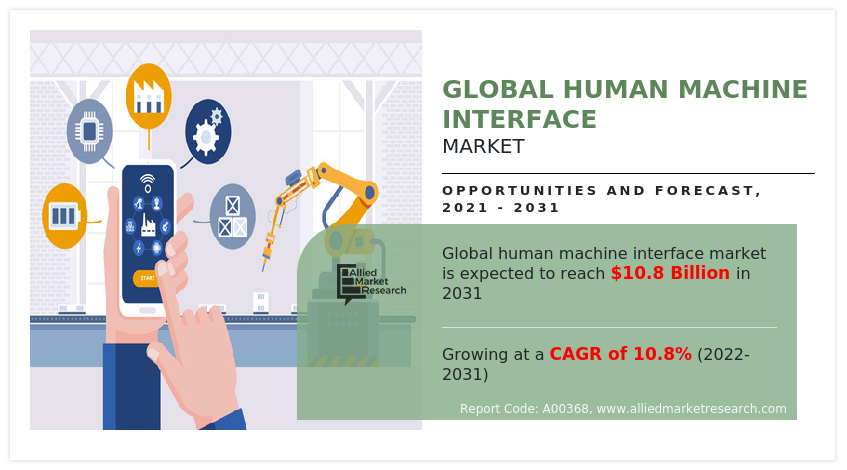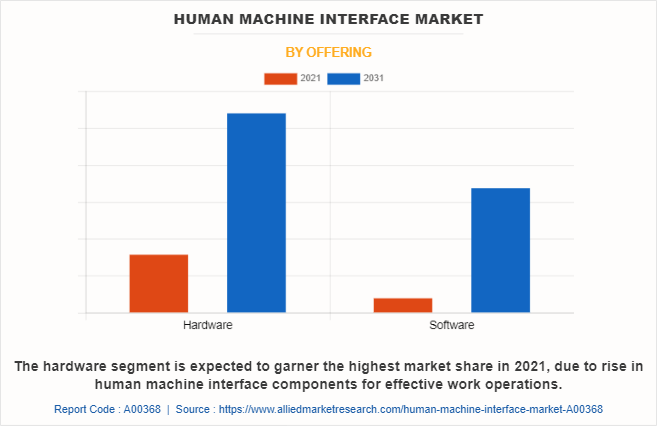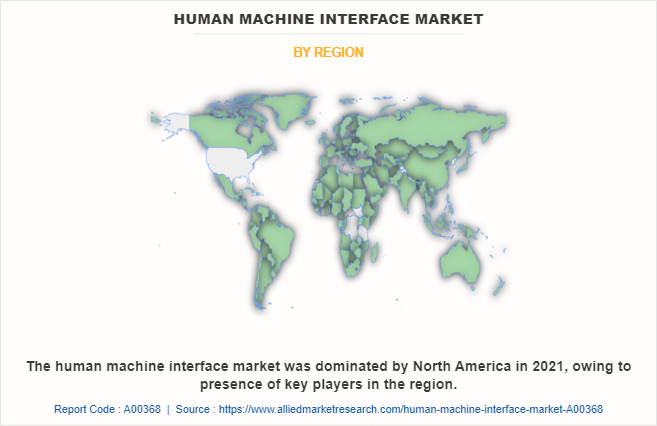Human Machine Interface Market Statistics, 2031
The global human machine interface market size was valued at $4 billion in 2021, and is projected to reach $10.8 billion by 2031, growing at a CAGR of 10.8% from 2022 to 2031.
Surge in industrial automation drives the human machine interface market growth. Industrial factories and control automation devices are executed for reducing human interaction in the development of products and services. This, in turn, reduces labor and production costs thereby helping to increase the production output. In addition, increase in demand for monitoring the production plants in various industries such as mining, automotive, and oil and gas drives the significant demand for human machine interface. These factors drive the growth of the human machine interface market. However, the installation cost of a human machine interface system is high, which restrains the growth of the human machine interface market. On the contrary, the increase in popularity of AR and VR technology and multi-touch screens is anticipated to provide lucrative opportunities for the growth of the human machine interface market.

A human machine interface (HMI) is an electronic device component that allows the user to easily communicate and interact with the machine or system. HMI is made up of a number of hardware and software components that convert human inputs into signals that the machine may use to produce results. Moreover, motion sensors, peripheral devices, speech-recognition interfaces, and other devices are used to transmit information via sound, sight, heat, and touch. It helps to reduce errors while also improving customer satisfaction, efficiency, and comfort.
Segment Review
The human machine interface market is segmented on the basis of offering, deployment mode, configuration, end user, and region. On the basis of offering, it is bifurcated into life hardware and software. On the basis of deployment mode, it is bifurcated into on-premise and cloud. On the basis of configuration, it is bifurcated into embedded HMI and standalone HMI. On the basis of end user, it is segmented into oil and gas, food and beverages, chemicals, pharmaceutical, metal and mining, automotive, aerospace and others. On the basis of region, it is analyzed across North America, Europe, Asia-Pacific, and LAMEA.

On the basis of offering, the hardware segment is the highest revenue contributor in 2021. This is attributed to the increase in need for businesses to reduce capital expenditure (CAPEX) and operational expenditure (OPEX). However, the software segment is anticipated to be the highest-growing segment in human machine interface market forecast due to the high rate of adoption of HMI software for automation.

On the basis of region, North America attained the highest growth in 2021. This is attributed to the rise in adoption of the latest technologies such as cloud computing, the IoT, and new service models. However, Asia-Pacific is the highest growing region due to rise in digital infrastructure and presence of number of SMEs.
Market Landscape and Trends
The market is anticipated to expand as a number of features, such as alarm warnings, safe messaging, and improved internal communications, are expected to provide an advantage to a facility regarding security, operations, and production. Newer HMI is expected to reduce operation costs by substituting traditional push buttons, indicator lights, and selectors and lowering the requirement of additional display panels and cables, and further enhancing monitoring of the machines.
Moreover, IoT is a dominating trend with industrial and consumer products being connected via the internet. In addition, the growing trend of protocol conversion for data transmission amongst all linked devices is expected to fuel HMI market growth. Furthermore, rapid industrial automation adoption in the manufacturing process, growth in adoption of mechanical development tools in the manufacturing sector, and rise in demand for smart industrial solutions are major trends in the HMI market.
Top Impacting Factors
Surge in industrial automation
Industrial automation refers to practices of software and control systems to monitor and operate independently as mechanized system solutions of manufacturing processes. Industrial factories and control automation devices are executed for reducing human interaction in the development of products and services. This, in turn, reduces labor and production costs, thereby helping to increase the production output. Moreover, human machine interface (HMI) plays a vital part in industrial automation to improve industrial controls. Many industries such as packaging, pharmaceutical, energy, mining, automobile, petrochemical, and oil & gas has witnessed automation in the recent past.
In addition, the integration of advanced HMI solutions and connectivity technology with various industrial automation equipment has tremendously increased the quality, productivity, and mobility of plant assets such as machinery and equipment. These factors are expected to drive growth of the global human machine interface industry during the forecast period.
Increase in Demand for Monitoring the Production Plants
The growth in need for efficiently monitoring the production plants in various industries such as mining, automotive, and oil and gas drives the significant demand for HMI software. Moreover, rise in demand for smart technological solutions across the manufacturing and processing industries is expected to spur the human machine interface market growth. In addition, the blending of technological and logical software is anticipated to enhance quality and productivity, thereby leading to an increase in demand for human interface systems.
Furthermore, the introduction of IIOT and HTML5 enables end users with more convenience and flexibility to propel the human machine interface industry growth. The launch of the latest version of software programs is projected to allow optimum running, visualization, and analyzing equipment and machinery across industries. Moreover, there is growth in market for human-machine interfaces as a result of a number of issues, including strict regulations for the adoption of energy efficiency, workplace safety, and rise in labor wages.
High Costs and Investment
The installation cost of a human machine interface system is high, which acts as a major restraint for the growth of the market. The high installation cost of the HMI system is due to the involvement of various stages, such as consultation, acquisition, implementation, and running costs, that further increases the expenditure of the installing company. Moreover, some advanced technologies including multi-touch screen, laser key panels, voice recognition, and gesture recognition are expensive to purchase and install. . The huge installation cost and lack of skilled operators is the main factor behind the slow adoption of these technologies. These factors are expected to hinder the market growth during the forecast period.
Inadequate HMI design
Human machine interface provides numerous advantages, but it still has various deficiencies that can result in accidental and psychological risks. Moreover, the use of inadequate HMI systems can lead to various occupational accidents. HMI systems are complex and need to be operated by skilled personnel. These operators require proper training regarding the use of the systems. In addition, the machine operator may suffer from cognitive overload in case information provided by systems is ambiguous or not readily understandable. In some cases, accidents occur due to operational errors such as failure to act other information provided by the interface or inability to operate machine correctly. All these factors are expected to restrain growth of the global human machine interface market during the forecast period.
Rise in Deployment of Advanced Technologies
The increase in popularity of AR and VR technology and multi-touch screens fuel the growth of the market. Moreover, loT has transformed the operations of various industries, including manufacturing. The application of loT across manufacturing industries can be termed Industrial loT. In addition, the human machine interface is projected to reduce the operational expenses by substituting various indicator lights, selectors, and push buttons, along with lowering the necessity of additional cables and display panels. Furthermore, with the implementation of a flexible HMI facility, managers can improve productivity by reducing start-up time. All these factors are projected to provide lucrative opportunities for the growth of the human machine interface market share.
Increase in Adoption of Mobile HMIs
Mobile HMIs are gaining popularity, as connectivity becomes increasingly indispensable in industrial automation. They allow workers who need access to information about their machines while out on the shop floor to connect with data systems without needing to return to the control room or office to do so. Moreover, mobile devices are being used as an interface for IIoT systems, allowing machine parameters to be monitored and controlled wherever the device is located. In addition, modern HMIs allow manufacturing plants of all sizes to achieve greater efficiency through faster performance, improved connectivity, and more intuitive user interfaces that promote safety of operators. The future of HMI is bright, with all aspects of plant control being revolutionized by connectivity, mobile technology, and automation.
Key Benefits for Stakeholders
- This report provides a quantitative analysis of the market segments, current trends, estimations, and dynamics of the human machine interface market analysis from 2021 to 2031 to identify the prevailing human machine interface market opportunities.
- The market research is offered along with information related to key drivers, restraints, and opportunities.
- Porter's five forces analysis highlights the potency of buyers and suppliers to enable stakeholders to make profit-oriented business decisions and strengthen their supplier-buyer network.
- In-depth analysis of the human machine interface market segmentation assists to determine the prevailing market opportunities.
- Major countries in each region are mapped according to their revenue contribution to the global market.
- Market player positioning facilitates benchmarking and provides a clear understanding of the present position of the market players.
- The report includes an analysis of the regional as well as global human machine interface market trends, key players, market segments, application areas, and market growth strategies.
Human Machine Interface Market Report Highlights
| Aspects | Details |
| Market Size By 2031 | USD 10.8 billion |
| Growth Rate | CAGR of 10.8% |
| Forecast period | 2021 - 2031 |
| Report Pages | 240 |
| By Industry Vertical |
|
| By Offering |
|
| By Deployment Mode |
|
| By Configuration |
|
| By Region |
|
| Key Market Players | General Electric, ABB, Rockwell Automation, Inc., Siemens AG, Mitsubishi Electric Corporation, Advantech Co., Ltd., Emerson Electric Co. , Honeywell International Inc., Schneider Electric, Yokogawa Electric Corporation |
Analyst Review
A human machine interface (HMI) is an electronic device component that allows the user to easily communicate and interact with the machine or system. HMI allows human operators to monitor the state of a process under control, modify control settings to change the control objective, and manually override automatic control operations in case of an emergency.
Furthermore, market players are adopting collaboration strategies for enhancing their services in the market and improving customer satisfaction. For instance, on October 2020, Emerson Electric Co. acquired the Progea Group, an industry-leading provider of HMI, SCADA, and PLC solutions. This acquisition is anticipated to bring new capabilities and resources and create opportunities to deliver end-to-end hardware and software solutions to customers of Emerson.
Some of the key players profiled in the report include ABB, Advantech Co., Ltd., Emerson Electric Co., Honeywell International Inc., General Electric, Mitsubishi Electric Corporation, Rockwell Automation, Inc., Schneider Electric, Siemens AG and Yokogawa Electric Corporation. These players have adopted various strategies to increase their market penetration and strengthen their position in the human machine interface market.
The global human machine interface market was valued at $3.9 billion in 2021 and is projected to reach $10.8 billion by 2031, growing at a CAGR of 10.8% from 2022 to 2031.
Surge in industrial automation and increase in demand for monitoring the production plants in various industries such as mining, automotive, and oil and gas drives the significant demand for human machine interface.
North America is the largest regional market for Human Machine Interface Market.
ABB, Advantech Co., Ltd., Emerson Electric Co., Honeywell International Inc., General Electric, Mitsubishi Electric Corporation, Rockwell Automation, Inc., Schneider Electric, Siemens AG and Yokogawa Electric Corporation.
The key growth strategies include product portfolio expansion, acquisition, partnership, merger, and collaboration.
Loading Table Of Content...
Loading Research Methodology...


